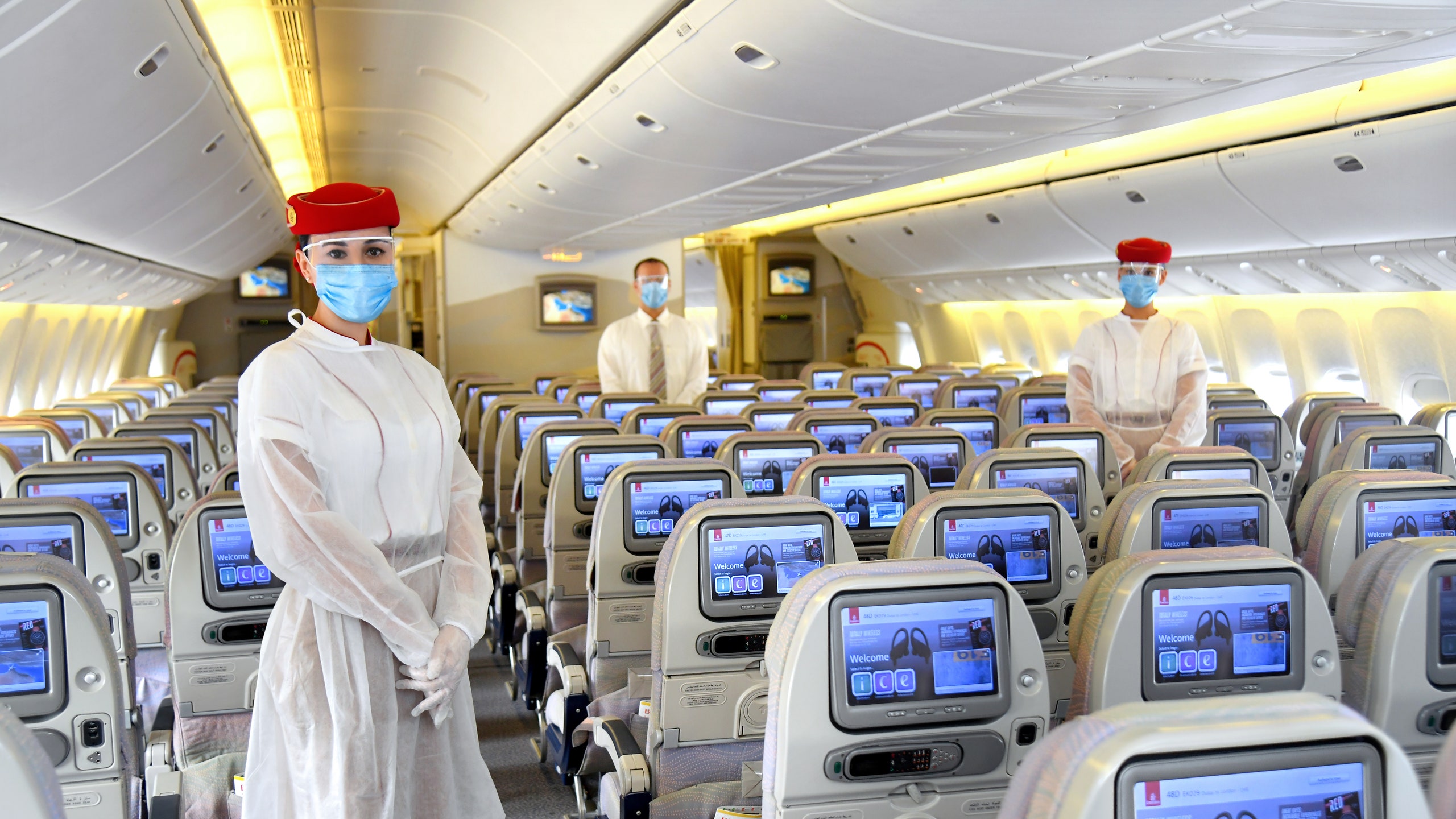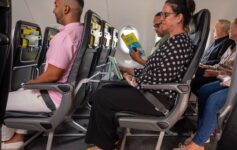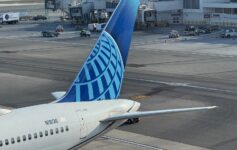
We often debate the viability, practically, and benefit of social distancing on airplanes. But what does the science say blocking middle seats?
The Science Behind Social Distancing + Middle Seat Blocking Onboard Airplanes
Live and Let’s Fly has a wide readership, including in the scientific community. One reader took the time to write a very thoughtful note and detailed argument for why social distancing, even if it is only an open middle seats, does play an important role in slowing the spread of virus.
I’m not a scientist and I have no way, beyond applying my layman knowledge of the subject, to critically review the argument below. But I present you excerpts from the letter, which is certainly worthy of our consideration.
First, the scientist established their credentials, also expressing “concern that you are inadvertently misleading your readers about the risk factors associated with the lack of in-flight social distancing.”
The issue is not whether six feet of social distancing is possible, but whether blocked middle seats provide enough additional protection to justify keeping them open.
I agree with you that it is impossible to maintain six feet socialdistancing on planes. I also agree with you that airlines will lose money on every flight if they block middle seats and maintain the current fares, and it is unreasonable to shame airlines for selling their flights full in a competitive marketplace where customers will just book with your competitors if you charge a 50% premium for socialdistancing.
I strongly disagree that there is no value in blocking middle seats; in fact I would strongly advocate that all airlines be forced to block middle seats, either through public pressure or a federal mandate. I would hope that this would create upward pressure on prices, especially since the reduced demand currently present is comprised of travelers who really need to travel and thus likely less sensitive to prices. I would be open to increased government aid as well. But since you have a large readership, hopefully people like you can do your part in better informing customers so that they can vote with their wallet and pressure United and American to match Delta in blocking middle seats.
I am not trying to raise any hysteria. I myself flew multiple times during the pandemic to see loved ones. I understand that airplanes are actually one of the safest environments among various modes of mass transportation. They have clean filtered air that flows from top to bottom, and the rate of circulation is high enough that the viral load is significantly reduced even in the presence of an infected patient. But right now, all mass transportation poses a significant risk, airplanes included.
Here’s the key part that I think you are missing: socialdistancing is not a binary between six feet or nothing. We have some decent data on the efficacy of various levels of socialdistancing, and we also have research on how viruses spread within airplanes. Because of the air flow pattern in an airplane, only passengers in close proximity to an infected passenger are significantly at risk (unless he or she has some other close interaction during in-flight service or boarding).
A good rule of thumb is that infection risk seems to approximately fall by half with every 0.5 meters of distance. So the seat next to you at 0.5 meters is twice the risk of the one at 1.0 meters, and generally speaking, about 1.5 meters of socialdistancing seems barely enough to mitigate the spread of the virus enough so that it does not spread exponentially.
So let’s pick an example: a 737 jet with 32-inch seat pitch and 17.5-inch wide seats and a 20-inch aisle.
1. Delta, 60% capacity, window seats:
0 person at 0.0~0.5m (x4), 2.7 persons at 0.5~1.0m (x2), 1.8 persons at 1.0~1.5m
= equivalent of 7.2 persons at 1.0~1.5m distance
2. Delta, 60% capacity, aisle seats:
0 person at 0.0~0.5m (x4), 3.6 persons at 0.5~1.0m (x2), 3.6 persons at 1.0~1.5m
= equivalent of 10.8 persons at 1.0~1.5m distance
3. United, 100% capacity, window seats:
1 person at 0.0~0.5m (x4), 5 persons at 0.5~1.0m (x2), 2 persons at 1.0~1.5m
= equivalent of 16 persons at 1.0~1.5m distance
4. United, 100% capacity, aisle seats:
1 person at 0.0~0.5m (x4), 6 persons at 0.5~1.0m (x2), 5 persons at 1.0~1.5m
= equivalent of 21 persons at 1.0~1.5m distance
5. United, 100% capacity, middle seats:
2 persons at 0.0~0.5m (x4), 6 persons at 0.5~1.0m (x2), 1 persons at 1.0~1.5m
= equivalent of 21 persons at 1.0~1.5m distance
Thus, an average Delta customer faces the risk equivalent of 9 persons at 1.0~1.5m distance, and an average United customer faces the risk equivalent of 19.3 persons at 1.0~1.5m distance. An average United customer faces more than twice as much risk on board as an average Delta customer. You might think a factor of two is not significant, but because an epidemic grows exponentially, a factor of two can make the difference between an exploding epidemic and a decaying one. If the R0 value [basic reproduction number] of COVID-19 is around 2.5, and universal mask wearing cuts the risk factor a bit (even if planes are slightly higher risk than the average environment), further reduction by another factor of two can bring the R value below 1.0, and we know that exponents below 1.0 eventually decay to zero.
This is obviously a very rough back-of-the-envelope calculation intended to be an illustrative example, but proper researchers in the field have run much more sophisticated epidemics models with real-world statistics and computer simulations.
More Resources On The Science Behind Middle Seat Blocking
The scientist recommended two further sources to explore this issue:
- Scientists know ways to help stop viruses from spreading on airplanes. They’re too late for this pandemic.
- At least 3 feet of social distancing likely reduces COVID-19 spread, study confirms
This morning, I also happened to read another story on this topic in ZDnet which chronicles the research of MIT scholar Arnold Barnett and makes many of the arguments made above. It also helps to explain risk:
The average risk of catching COVID-19 from flying on a plane is 1 in 4,300, according to Barnett’s model. That rate is roughly double the risk if airlines were to leave the middle seat open, 1 in 7,700, Barnett estimates. Using a relatively low fatality rate of 1% of all people who contract COVID-19, he estimates, means that the 1 in 4,300 risk of catching COVID-19 turns into a risk of dying from the disease of 1 in 430,000. That is much more likely than the standard measure of risk of dying by airplane crash, which is 1 in 34 million.
Does a risk level of this nature even matter?
With 200,000 passengers per day being carried by the major U.S. airlines over the next three months, a total of perhaps 18 million passengers will be carried in the U.S. at the current rate of bookings, he explained. Going from the 1 in 7,700 Covid-19 risk per passenger with the middle seat filled to just 1 in 4,300 with it empty would avert 1,800 Covid-19 infections, he argues, and 18 potential deaths at a fatality rate of 1%.
Using a value of $9 million for a human life, which is a figure described by Boston University researcher Austin Frakt as roughly the value U.S. government agencies use, the dollar equivalent of the 18 lost lives would be about $173 million.
“It is hard to imagine that the cost to American Airlines and United of averting those deaths would be anywhere near $173 million in the coming months,” Barnett said.
The entire article is quite interesting:
- Filling middle seats nearly doubles airline passenger risk of catching COVID-19, says MIT researcher
CONCLUSION
It is my goal to always use my platform of Live and Let’s Fly in a responsible manner. I’ve long discounted the benefit of leaving middle seats opens, but we clearly see that our calculus should not be six feet or nothing. Instead, we must continue to weigh risks and note the likely incremental benefits of even a few inches. I’m still not ready to advocate for mandatory middle seat blocking. But my continuing research on the matter is helping me–and will hopefully help you–more smartly think about this topic.
image: Emirates




Very interesting. It does seem the main talking points around blocking middle seats has been “6 feet or bust” and therefore blocking middle seats provides no value since it’s not 6 feet. I’m sure Kirby has a spreadsheet somewhere which can counter this analysis.
Jf the standard is whether there is “no value in blocking middle seats” then of course advocates for middle seat blocking win. A traveler might wind up sitting directly next to someone with the virus, sharing an armrest, get coughed on, etc.
The question is how much actual risk of spread is there on an aircraft, and how much of that risk is reduced by middle seat blocking. The answer seems to be not very much total risk (flights haven’t been identified as a significant vector of spread), so reducing risk a little bit probably shouldn’t be a public policy priority.
We face risk tradeoff decisions every day. You can get into a car accident driving. People drown in buckets every year. It sure seems like restaurants at 50% capacity in some states are a much greater risk than middle seats, as are gyms which are open in several states. Seems like we ought to focus there first.
In normal times we know that air travel is much safer than driving, so higher fares which push people onto the roads cost lives. If taking 1/3 of seats out of supply increases price, would people substitute driving for flying and lead to worse public health outcomes even?
We can grant that ‘blocking middle seat is better than not blocking middle seat’ in terms of first-order effects without respect to cost, but if that were true then “going full Wuhan” would be the preferred policy stance with respect to the virus…
I thought 1300 words was enough already for my post, but you make the same arguments I would (and have in other posts). Indeed, virtually every activity in life is a cost-benefit analysis. And even with unknown variables, I would sit in a middle seat today and don’t think the analysis above justifies compulsory middle seat blocking, though the $$ figures do merit further discussion.
I appreciate your willingness to explore alternative explanations that challenge your beliefs. I wish more people did the same!
Wow. Great post and analysis.
I am not flying for now. If I had to, as painful and expensive as it would be, I would buy 9 seats in a 737 for me. If airlines cooperated, it could be cut to 6 seats if they grouped like minded people together (empty row in front and behind a passenger)
The CDC best estimate for death rate from Covid-19 is 0.26%. This is a quarter of the 1% used in the article. If this is true, how does that change the calculations?
I don’t have much knowledge about the real costs for United or American for running extra flights, but I don’t understand the justification for $173m being less than the cost. Some quick calculations: 18m passengers, so if middle seat is blocked that’s 6m extra flight seats which means on middle seat blocked flights a total of about 45,000 extra flights. Which gives the cost per flight ($173m / 45,000) as $3,800. This sounds very low to me.
Of course, this assumes the flights are all 100% full. However if the flights are not 100% full the risk per flight is already reduced so the extra deaths will be lower already, I’m sure the calculations can be done to see what the overall effect is…
Airborne transmission, via aerosols & droplets, is one of the (strongly) suspected mechanisms. Due to the circulation patterns of the ambient air, the “added risk” due to this mechanism could be anywhere between 1X – 4X when the nominal distance between passengers is doubled, given all other factors remain the same. So an increased risk factor of 2X is reasonable.
There has been a lot of research, both observational as well as simulation studies of droplet spread, in Japan. Here is a recent news item from The Japan Times (video not in English): https://www.japantimes.co.jp/news/2020/07/08/national/japan-supercomputer-coronavirus-closed-spaces/
Interesting read.
I know that I once flew on a A320 sitting next to a woman coughing like mad on a ORD-IAD flight. I tried to turn my face away and lean my head into the aisle. Two days later, I was coughing like mad. It was the common cold, not influenza.
With this particular pandemic, I am reluctant to fly. And the biggest reason is that being crammed into an airplane isn’t your only challenge. While on the plane, you have some control regarding your liklihood of catching COVID: wear a mask, use hand sanitizer, stay in your limited area, try not to touch anything. You can plan for this. And the airlines are sanitizing like crazy.
It’s at the airport that your greatest risk lies, in my opinion. These tend to be germy places to begin with. The TSA screening area, gate areas, etc. see thousands of people every day. If you have ever caught a cold or illness on a trip, there’s a good chance that you may have caught it in one of these places. And having to potentially spend hours waiting around at the airport is a very unappealing concept to me.
‘The scientist’ Lol